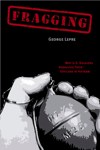 As a U.S. Army veteran who has authored one other military history book, George Lepre found it remarkable that no detailed study of fragging had ever been published, given the huge amount of writing on the Vietnam War. However, through a combination of documentary evidence from military records and interviews with veterans, Lepre has filled that void with this outstanding volume. The book not only analyzes the phenomena’s origins and causes, but also humanizes the victims of fragging by including their names and, sometimes, their photos, for as Lepre writes, “if there is any shame involved with fragging, it lies with the perpetrators, not the victims.”
As a U.S. Army veteran who has authored one other military history book, George Lepre found it remarkable that no detailed study of fragging had ever been published, given the huge amount of writing on the Vietnam War. However, through a combination of documentary evidence from military records and interviews with veterans, Lepre has filled that void with this outstanding volume. The book not only analyzes the phenomena’s origins and causes, but also humanizes the victims of fragging by including their names and, sometimes, their photos, for as Lepre writes, “if there is any shame involved with fragging, it lies with the perpetrators, not the victims.”
Fragging begins with an overview of how social change affected the military. In the early years, the U.S. Army in Vietnam was outstanding by any measure, and fragging was not a problem. As the war dragged on, however, morale and discipline in the ranks deteriorated, and standards fell to meet manpower needs. Arising from this milieu came “fragging,” defined as the use of an explosive device in a noncombat action with a goal of killing, injuring or intimidating the victim. Although there had long been similar assaults in the U.S. armed forces, they have never been as routine as they became in Vietnam.
Lepre cites two key events that provided “pivotal impetus” to fragging: President Richard M. Nixon’s announcement of troop withdrawals and the assassination of Martin Luther King Jr. The first provided a disincentive for soldiers to exert themselves, and the second ignited racial violence in the military.
The author’s research of hundreds of fragging investigation records revealed that fraggings, most of which were carried out in support units after dark, overwhelmingly occurred in the Army and Marine Corps and that they were rare in the Air Force and Navy. Drug use and racial militancy were contributing factors, and frequently innocent bystanders became the unintended victims of the attacks. Typically, the families of fragging victims were not told the details of their loved ones’ deaths.
While most perpetrators were never identified or punished, Lepre closely examined the records of the 71 soldiers and Marines who were convicted of the crimes in an attempt to discern a profile. He found that fraggers were younger than average, most came out of broken homes, and two-thirds were high-school dropouts. Blacks were overrepresented, and whites underrepresented. According to their psychiatric records, fraggers were immature, had low self-esteem, and were mediocre soldiers. Most of them used illegal drugs. Interestingly, few were draftees and there is no direct evidence that antiwar activism was a motive for these crimes.
The military responded with vigorous investigations and prosecutions. On the prevention side, access to grenades in rear areas was severely restricted as they were inventoried and soldiers had to account for them. Programs to reduce racial strife and drug use were instituted. In spite of these efforts, incidents of fragging did not decrease, and the apprehension of fragging perpetrators did not increase. Fragging incidents peaked in March 1971, about the time the American media began reporting the problem in detail.
Although many of those convicted received substantial prison terms for their crimes, nearly all were freed by the end of the 1970s. Lepre describes the fate of many convicted fraggers, for most of whom it did not turn out very well.
Lepre concludes, “It was no accident that the fragging phenomenon occurred during an unpopular war,” which led to a fall in morale in the armed forces. This decline, coupled with drug abuse, racial tensions and the rebellion of American youth, came together in a way that undermined the efficacy of the military’s traditional personnel control mechanisms, leaving the military largely unable to cope with the problem. The only way to end fragging was to end the war.
This first-rate account is complete with glossary of terms, appendices containing statistical data on fraggings and fraggers, hundreds of footnotes and an extensive bibliography. It is highly recommended for everyone interested in the performance of the U.S. military in Vietnam.
Texas Tech University Press, 2011
This Review appeared in the April 2011 issue of Vietnam magazine.




